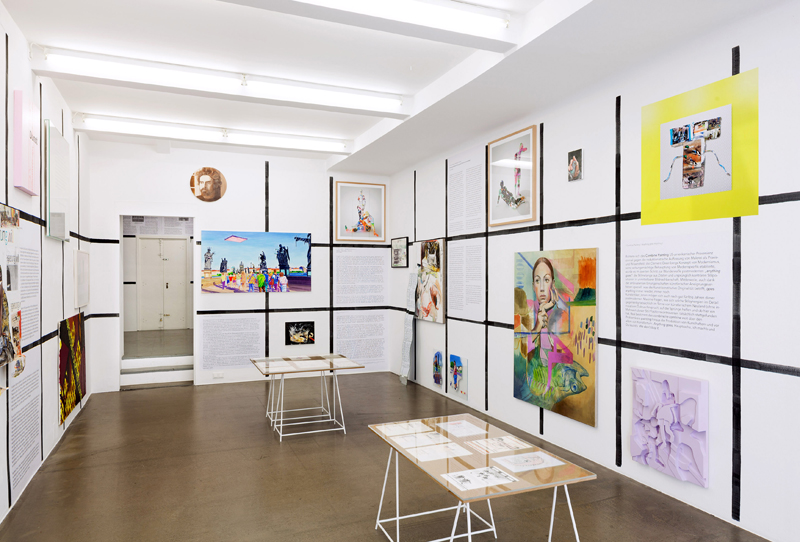 |
| Ausstellungsansicht "The Happy Fainting of Painting #2", Galerie Krobath, Wien, 2017 |
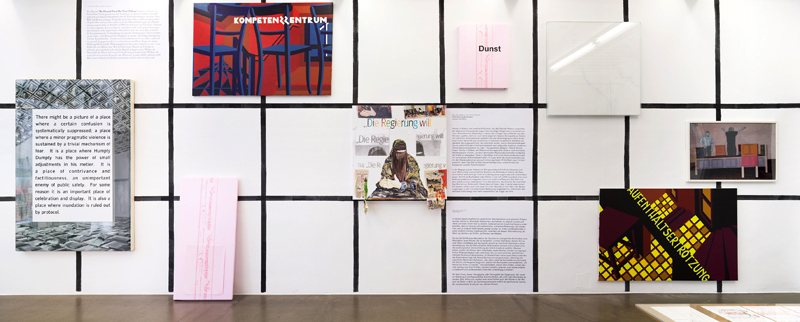 |
The Happy Fainting of Painting #2
Galerie Krobath / Curated by_vienna 2017
14. September bis 14. Oktober 2017
Kuratiert von Hans-Jürgen Hafner & Gunter Reski
Mit Art & Language, Josef Bauer, Sabeth Buchmann, HC Dany, Helmut Draxler, Heinrich Dunst, Fabian Ginsberg, Ellen Gronemeyer, Hans-Jürgen Hafner, Rosa Hausleithner, Stefan Hayn, Christian Höller, Claudia Kugler, Christine Lemke, Anna Meyer, Ariane Müller, Robert Müller, Vanessa Joan Müller, Berthold Reiß, Gunter Reski, Pieter Schoolwerth, Lin May Saeed, Avery Singer, Dominik Sittig, Paul Sochacki, Catharina Szonn, Anke Völk, Marcus Weber, Claudia Zweifel
„The Happy Fainting of Painting #2” entwirft sich als mutwillig didaktisches Bild/Text-Layout auf Basis des dem Kompositionsregister des Modernismus entwendeten grid: darin begegnen sich Kunstwerke und Theoriebeiträge buchstäblich auf Augenhöhe und stellen so im gegenseitigen Bezug augenfällig Diskursivität her. Die Essayschau führt eine Diskussion über und mit Malerei fort, deren bisheriger Stand im Sammelband „The Happy Fainting of Painting“ (Walther König, 2014) dokumentiert und in einer ersten Ausstellung in der Berliner Zwinger Galerie (2012) initiiert worden war.
Tatsächlich konnte Malerei (auf ihrem Weg von der Technik zur Kunst) von außen an sie herangetragene neue Künste wie technische Ressourcen sich bisher stets im produktiven Sinne einverleiben bzw. diesen etwas abgewinnen. Das betrifft ihre – als Malerei, Bild und Kunst je spezifischen – Produktions- und Verwendungsweisen, alternative Bildtechnologien und visuelle Industrien, ihre Geschichte als Medium oder Sammlungstool von Bildern und Wissen im Hinblick auf ein mögliches kollektives Gedächtnis. Egal ob als historische Metaebene oder traditionelles Bildmedium kann sie nach wie vor selbst dominante visuelle Kulturen wie etwa die Werbung kritisch reflektieren und mitunter transzendieren. Jeder ihrer prognostizierten Tode hat sich bisher, und sei es nur zeitweilig, als Frischzellenkur erwiesen. Wenn es ein Medium gibt, das sich durch Krisen am Leben erhält, ist das die Malerei.
Entsprechend hat sich das Traditionsmedium Malerei durch neue, digitale Technologien und deren Verwendung in der Kunst keineswegs ‚erübrigt’, wie die Ausstellung „Painting 2.0 – Malerei im Informationszeitalter“ (Museum Brandhorst, München / MUMOK, Wien, 2015/16) gezeigt hat. Der mit dieser Ausstellung verbundene Kanonisierungsschub verdient allerdings eine kritische Revision und dringend Fortschreibung. Hier wurde mit einer letztlich verengten Perspektive auf Malerei (und Kunstbetrieb) als regelrechte Institution der Zugang gleichermaßen zur Kunst wie zu den Bildern verstellt. Mit Bildern wären hier visuell-kognitive Potentiale gemeint, die im kunstimmanenten und/oder gesellschaftlichen Rahmen Wirkung zeigen, also nicht auf Malereiimmanenz festgeschrieben sind.
In diesem Sinne sind die fünf Kategorien zu verstehen, die „The Happy Fainting of Painting“ als Arbeitshypothesen einführt, um Kunst-, Malerei- und Bilddiskurse aus der aktuellen malerischen Produktion heraus anzustoßen. Die Kapitel „The Painted Word/Das Wort ‚Malerei“, „Nach der Abstraktion der Abstraktion“, „Postironie“, „Combine Painting/anything goes anything“ und „Realismen/Dokumentarmalerei“ füllen sich ohne Anspruch auf Themenerfüllung gleichwertig mit künstlerischen und theoretischen Beiträgen von Künstler_innen, Theoretiker_innen und Interessierten dieser medialen Sachlage. Die Ausstellung, so sehr sie in den Einzelfall von Bild und Meinung zerfallen mag, ergibt ein vielstimmiges Schaubild der wechselseitigen und neuen Bezüge.
Alle Textbeiträge in der Ausstellung als PDF
|
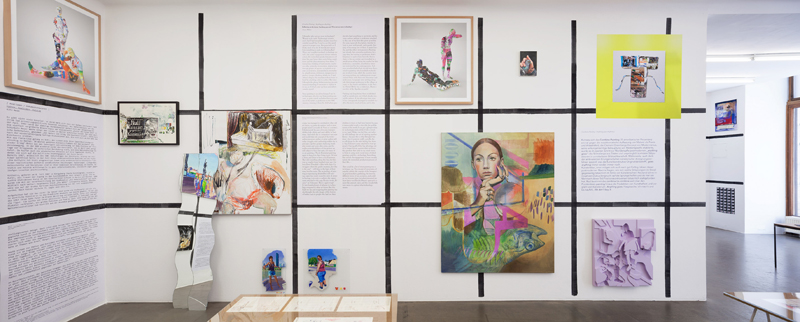 |
| Ausstellungsansicht "The Happy Fainting of Painting #2", Galerie Krobath, Wien, 2017 |
 |
| Ausstellungsansicht "The Happy Fainting of Painting #2", Galerie Krobath, Wien, 2017 |
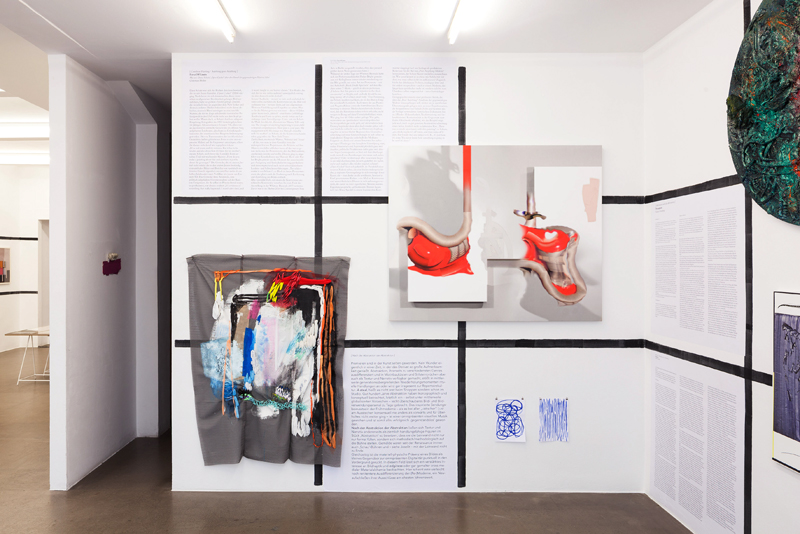 |
| Ausstellungsansicht "The Happy Fainting of Painting #2", Galerie Krobath, Wien, 2017 |
 |
| Lin May Seed, Blue Nile Relief I, 2011 |
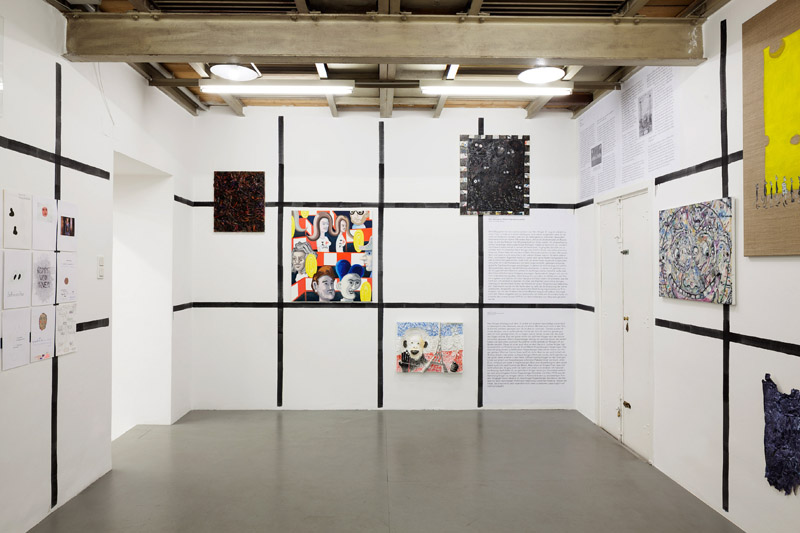 |
| Ausstellungsansicht "The Happy Fainting of Painting #2", Galerie Krobath, Wien, 2017 |
|
“The Happy Fainting of Painting #2” is a deliberately didactic image/text arrangement based on a grid purloined from the compositional register of modernism: within this matrix, artworks and theoretical contributions find themselves on a level field, their interplay generating discursivity in a striking manner. This essay-exhibition continues a discussion about and with painting that has previously been documented in the anthology “The Happy Fainting of Painting” (Walther König, 2014) and that was initiated in a first exhibition at Berlin’s Zwinger Galerie (2012).
In the past (on its path from technique to art) painting has always been able to integrate new art forms and technical resources brought to it from outside in a productive way, gaining something from them. This applies (in different ways for painting, picture and art respectively) to its modes of production and usage, alternative image technologies and visual industries, its history as a medium or tool for capturing pictures and knowledge with regard to a possible collective memory. Whether as a historical meta-level or a traditional picture medium, it is still capable of critically reflecting on and sometimes transcending even dominant visual cultures like advertising. To date, each of its predicted deaths has proved to be, even if only temporarily, an injection of new life. If there is one medium that is kept alive by crises, then it is painting.
Correspondingly, the traditional medium of painting has not been rendered obsolete by new digital technologies and their use in art, as shown by the exhibition “Painting 2.0 – Expression in the Information Age” (Museum Brandhorst, Munich / MUMOK, Vienna, 2015/16). However, the canonization associated with this show needs to be critically revised and followed up. With a narrow focus on painting (and the art business) as a veritable institution, the show blocked access both to the art and to the pictures – pictures here meaning visual-cognitive potentials that take effect within an art-specific and/or social framework, not being limited to painting itself.
This is the intention of the five categories introduced by “The Happy Fainting of Painting #2” as working hypotheses to stimulate discourse on art, painting and picture theory from within current painterly production. With no claim to covering their theme completely, the sections “The Painted Word/The Word ‘Painting’”, “After the Abstraction of Abstraction“, “Post-Irony”, “Combine Painting/Anything Goes Anything” and “Realisms/Documentary Painting” are filled to equal degree with artistic and theoretical contributions by artists, theorists, and others interested in this media situation. However much it may break down into individual cases of picture and opinion, the exhibition adds up to a many-voiced tableau of new points of reference and interrelations.
(Translated by Nicholas Grindell)
Contributing artists & authors: Josef Bauer, Sabeth Buchmann, HC Dany, Helmut Draxler, Heinrich Dunst, Fabian Ginsberg, Ellen Gronemeyer, Hans-Jürgen Hafner, Flora Hausleithner, Stefan Hayn, Christian Höller, Claudia Kugler, Christine Lemke, Anna Meyer, Ariane Müller, Robert Müller, Vanessa Joan Müller, Gunter Reski, Pieter Schoolwerth, Lin May Seed, Avery Singer, Dominik Sittig, Paul Sochacki, Catharina Szonn, Anke Völk, Marcus Weber, Claudia Zweifel …
|
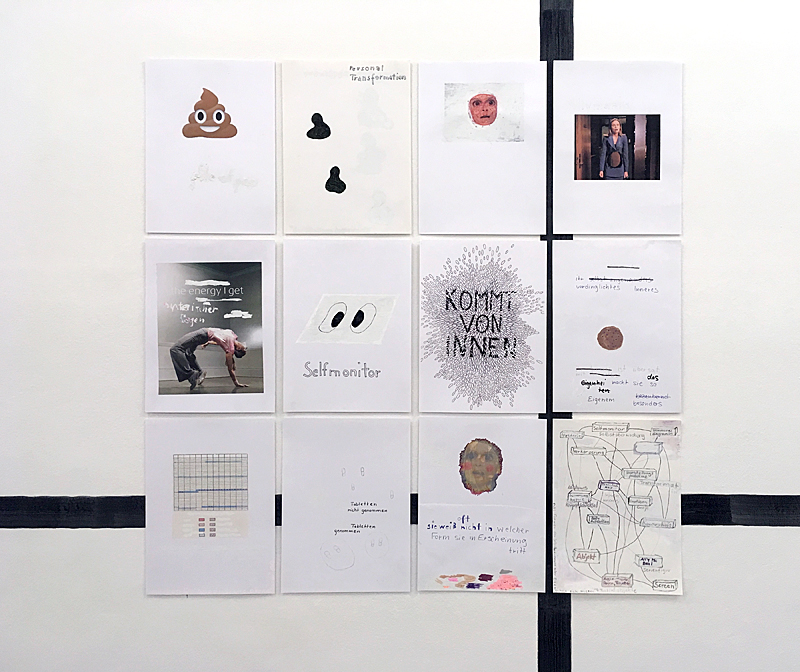 |
| Insert Christine Lemke |
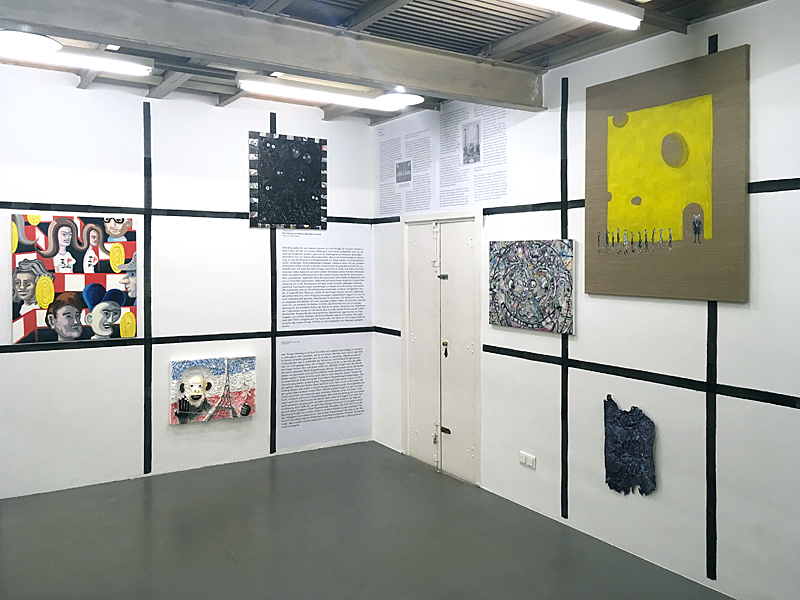
|
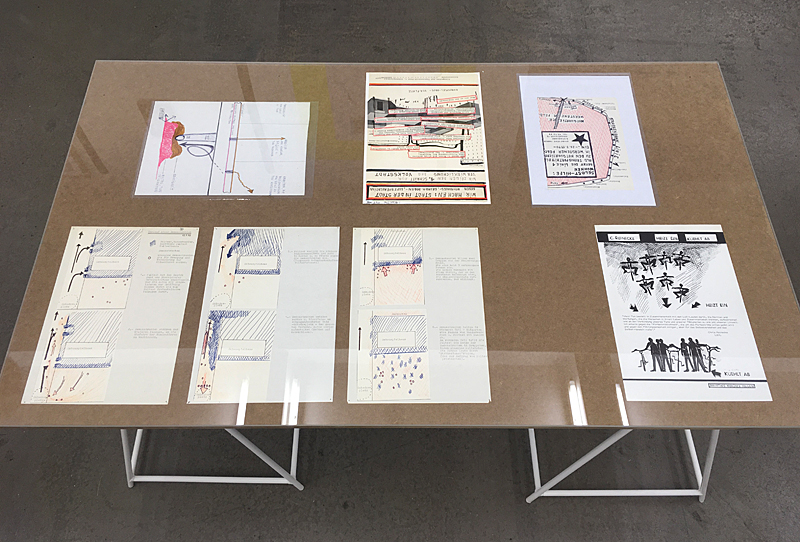 |
Chris Reinecke, LIDL Aktion Kunsthalle Köln 1970 Mietersolidarität |
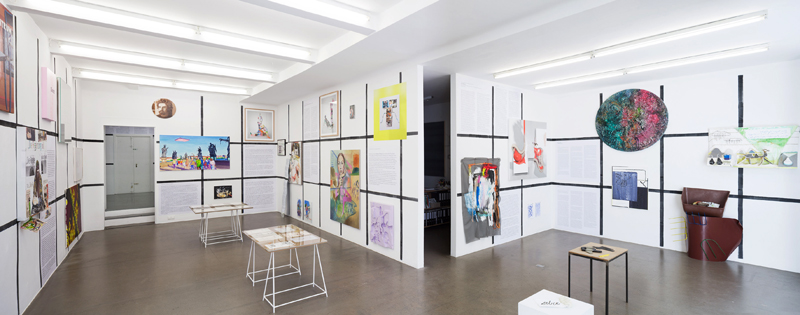 |
| Ausstellungsansicht "The Happy Fainting of Painting #2", Galerie Krobath, Wien, 2017 |
 |
Birgit Megerle, Cash I, 2016
|
|
|
|
|











